宏观经济学习题及答案(15)
宏观经济学习题及参考答案
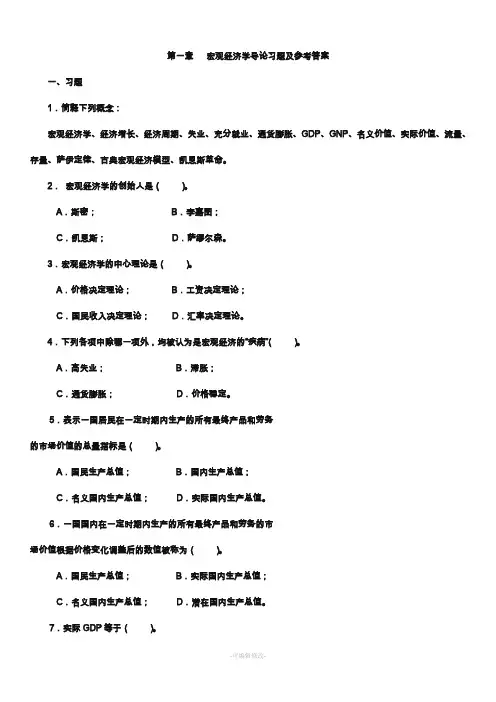
第一章宏观经济学导论习题及参考答案一、习题1.简释下列概念:宏观经济学、经济增长、经济周期、失业、充分就业、通货膨胀、GDP、GNP、名义价值、实际价值、流量、存量、萨伊定律、古典宏观经济模型、凯恩斯革命。
2.宏观经济学的创始人是()。
A.斯密;B.李嘉图;C.凯恩斯;D.萨缪尔森。
3.宏观经济学的中心理论是()。
A.价格决定理论;B.工资决定理论;C.国民收入决定理论;D.汇率决定理论。
4.下列各项中除哪一项外,均被认为是宏观经济的“疾病”()。
A.高失业;B.滞胀;C.通货膨胀;D.价格稳定。
5.表示一国居民在一定时期内生产的所有最终产品和劳务的市场价值的总量指标是()。
A.国民生产总值;B.国内生产总值;C.名义国内生产总值;D.实际国内生产总值。
6.一国国内在一定时期内生产的所有最终产品和劳务的市场价值根据价格变化调整后的数值被称为()。
A.国民生产总值;B.实际国内生产总值;C.名义国内生产总值;D.潜在国内生产总值。
7.实际GDP等于()。
A.价格水平/名义GDP;B.名义GDP/价格水平×100;C.名义GDP乘以价格水平;D.价格水平乘以潜在GDP。
8.下列各项中哪一个属于流量?()。
A.国内生产总值;B.国民债务;C.现有住房数量;D.失业人数。
9.存量是()。
A.某个时点现存的经济量值;B.某个时点上的流动价值;C.流量的固体等价物;D.某个时期内发生的经济量值。
10. 下列各项中哪一个属于存量?()。
A. 国内生产总值;B. 投资;C. 失业人数;D. 人均收入。
11.古典宏观经济理论认为,利息率的灵活性使得()。
A.储蓄大于投资;B.储蓄等于投资;C.储蓄小于投资;D.上述情况均可能存在。
12.古典宏观经济理论认为,实现充分就业的原因是()。
A.政府管制;B.名义工资刚性;C.名义工资灵活性;D.货币供给适度。
13.根据古典宏观经济理论,价格水平降低导致下述哪一变量减少()。
宏观经济学完整习题(附答案)
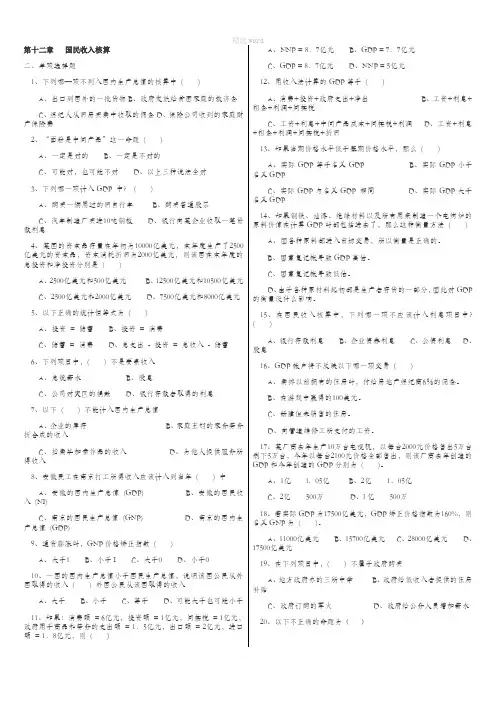
精选word第十二章国民收入核算二、单项选择题1、下列哪—项不列入国内生产总值的核算中( )A、出口到国外的一批货物B、政府发放给贫困家庭的救济金C、经纪人从旧房买卖中收取的佣金D、保险公司收到的家庭财产保险费2、“面粉是中间产品”这一命题( )A、一定是对的B、一定是不对的C、可能对,也可能不对D、以上三种说法全对3、下列哪一项计入GDP 中? ( )A、购买一辆用过的旧自行车B、购买普通股票C、汽车制造厂买进10吨钢板D、银行向某企业收取一笔贷款利息4、某国的资本品存量在年初为10000亿美元,本年度生产了2500亿美元的资本品,资本消耗折旧为2000亿美元,则该国在本年度的总投资和净投资分别是( )A、2500亿美元和500亿美元B、12500亿美元和10500亿美元C、2500亿美元和2000亿美元D、7500亿美元和8000亿美元5、以下正确的统计恒等式为( )A、投资= 储蓄B、投资= 消费C、储蓄= 消费D、总支出- 投资= 总收入- 储蓄6、下列项目中,( ) 不是要素收入A、总统薪水B、股息C、公司对灾区的捐献D、银行存款者取得的利息7、以下( ) 不能计入国内生产总值A、企业的库存B、家庭主妇的家务劳务折合成的收入C、拍卖毕加索作品的收入D、为他人提供服务所得收入8、安徽民工在南京打工所得收入应该计入到当年( ) 中A、安徽的国内生产总值(GDP)B、安徽的国民收入(NI)C、南京的国民生产总值(GNP)D、南京的国内生产总值(GDP)9、通货膨胀时,GNP价格矫正指数( )A、大于1B、小于IC、大于0D、小于010、一国的国内生产总值小于国民生产总值,说明该国公民从外国取得的收入( ) 外国公民从该国取得的收入A、大于B、小于C、等于D、可能大于也可能小于11、如果:消费额= 6亿元,投资额= 1亿元,间接税= 1亿元,政府用于商品和劳务的支出额= 1.5亿元,出口额= 2亿元,进口额= 1.8亿元,则( )A、NNP = 8.7亿元B、GDP = 7.7亿元C、GDP = 8.7亿元D、NNP = 5亿元12、用收入法计算的GDP等于( )A、消费+投资+政府支出+净出B、工资+利息+租金+利润+间接税C、工资+利息+中间产品成本+间接税+利润D、工资+利息+租金+利润+间接税+折旧13、如果当期价格水平低于基期价格水平,那么( )A、实际GDP等于名义GDPB、实际GDP小于名义GDPC、实际GDP与名义GDP 相同D、实际GDP大于名义GDP14、如果钢铁、油漆、绝缘材料以及所有用来制造一个电烤炉的原料价值在计算GDP时都包括进去了,那么这种衡量方法( )A、因各种原料都进入市场交易,所以衡量是正确的。
宏观经济学习题库(附参考答案)
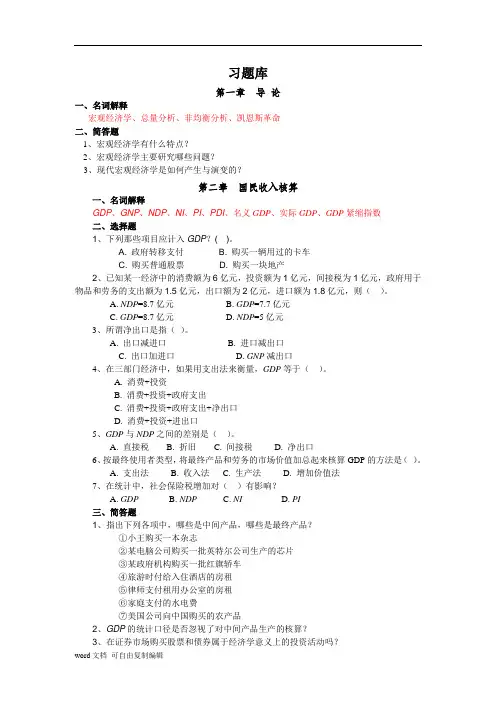
习题库第一章导论一、名词解释宏观经济学、总量分析、非均衡分析、凯恩斯革命二、简答题1、宏观经济学有什么特点?2、宏观经济学主要研究哪些问题?3、现代宏观经济学是如何产生与演变的?第二章国民收入核算一、名词解释GDP、GNP、NDP、NI、PI、PDI、名义GDP、实际GDP、GDP紧缩指数二、选择题1、下列那些项目应计入GDP?( )。
A. 政府转移支付B. 购买一辆用过的卡车C. 购买普通股票D. 购买一块地产2、已知某一经济中的消费额为6亿元,投资额为1亿元,间接税为1亿元,政府用于物品和劳务的支出额为1.5亿元,出口额为2亿元,进口额为1.8亿元,则()。
A. NDP=8.7亿元B. GDP=7.7亿元C. GDP=8.7亿元D. NDP=5亿元3、所谓净出口是指()。
A. 出口减进口B. 进口减出口C. 出口加进口D. GNP减出口4、在三部门经济中,如果用支出法来衡量,GDP等于()。
A. 消费+投资B. 消费+投资+政府支出C. 消费+投资+政府支出+净出口D. 消费+投资+进出口5、GDP与NDP之间的差别是()。
A. 直接税B. 折旧C. 间接税D. 净出口6、按最终使用者类型,将最终产品和劳务的市场价值加总起来核算GDP的方法是()。
A. 支出法B. 收入法C. 生产法D. 增加价值法7、在统计中,社会保险税增加对()有影响?A. GDPB. NDPC. NID. PI三、简答题1、指出下列各项中,哪些是中间产品,哪些是最终产品?①小王购买一本杂志②某电脑公司购买一批英特尔公司生产的芯片③某政府机构购买一批红旗轿车④旅游时付给入住酒店的房租⑤律师支付租用办公室的房租⑥家庭支付的水电费⑦美国公司向中国购买的农产品2、GDP的统计口径是否忽视了对中间产品生产的核算?3、在证券市场购买股票和债券属于经济学意义上的投资活动吗?4、为什么政府转移支付不能计入GDP?5、为什么间接税应该计入GDP?6、GDP指标有哪些缺陷或不足?7、为什么要区分名义国内生产总值和实际国内生产总值?8、国内生产总值与国民生产总值关系如何?四、计算题1、若某国GDP为8800单位,总投资为1150单位,净投资为292单位,消费为5800单位,政府购买的产品和劳务价值为1500单位,间接税为620单位,政府财政盈余为44单位,求该国NDP、净出口、个人可支配收入、个人储蓄各为多少。
宏观经济学习题库(附参考答案)
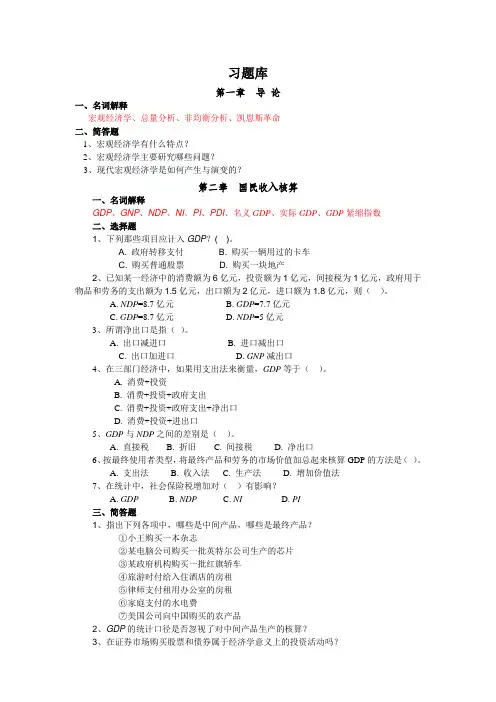
习题库第一章导论一、名词解释宏观经济学、总量分析、非均衡分析、凯恩斯革命二、简答题1、宏观经济学有什么特点?2、宏观经济学主要研究哪些问题?3、现代宏观经济学是如何产生与演变的?第二章国民收入核算一、名词解释GDP、GNP、NDP、NI、PI、PDI、名义GDP、实际GDP、GDP紧缩指数二、选择题1、下列那些项目应计入GDP?( )。
A. 政府转移支付B. 购买一辆用过的卡车C. 购买普通股票D. 购买一块地产2、已知某一经济中的消费额为6亿元,投资额为1亿元,间接税为1亿元,政府用于物品和劳务的支出额为1.5亿元,出口额为2亿元,进口额为1.8亿元,则()。
A. NDP=8.7亿元B. GDP=7.7亿元C. GDP=8.7亿元D. NDP=5亿元3、所谓净出口是指()。
A. 出口减进口B. 进口减出口C. 出口加进口D. GNP减出口4、在三部门经济中,如果用支出法来衡量,GDP等于()。
A. 消费+投资B. 消费+投资+政府支出C. 消费+投资+政府支出+净出口D. 消费+投资+进出口5、GDP与NDP之间的差别是()。
A. 直接税B. 折旧C. 间接税D. 净出口6、按最终使用者类型,将最终产品和劳务的市场价值加总起来核算GDP的方法是()。
A. 支出法B. 收入法C. 生产法D. 增加价值法7、在统计中,社会保险税增加对()有影响?A. GDPB. NDPC. NID. PI三、简答题1、指出下列各项中,哪些是中间产品,哪些是最终产品?①小王购买一本杂志②某电脑公司购买一批英特尔公司生产的芯片③某政府机构购买一批红旗轿车④旅游时付给入住酒店的房租⑤律师支付租用办公室的房租⑥家庭支付的水电费⑦美国公司向中国购买的农产品2、GDP的统计口径是否忽视了对中间产品生产的核算?3、在证券市场购买股票和债券属于经济学意义上的投资活动吗?4、为什么政府转移支付不能计入GDP?5、为什么间接税应该计入GDP?6、GDP指标有哪些缺陷或不足?7、为什么要区分名义国内生产总值和实际国内生产总值?8、国内生产总值与国民生产总值关系如何?四、计算题1、若某国GDP为8800单位,总投资为1150单位,净投资为292单位,消费为5800单位,政府购买的产品和劳务价值为1500单位,间接税为620单位,政府财政盈余为44单位,求该国NDP、净出口、个人可支配收入、个人储蓄各为多少。
宏观经济学考试试题及答案
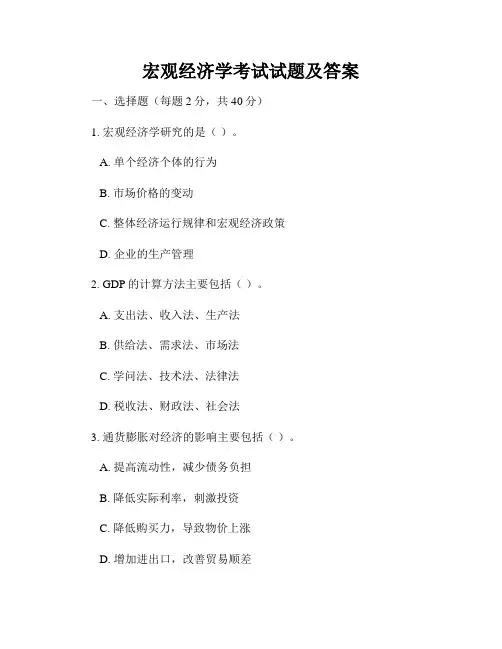
宏观经济学考试试题及答案一、选择题(每题2分,共40分)1. 宏观经济学研究的是()。
A. 单个经济个体的行为B. 市场价格的变动C. 整体经济运行规律和宏观经济政策D. 企业的生产管理2. GDP的计算方法主要包括()。
A. 支出法、收入法、生产法B. 供给法、需求法、市场法C. 学问法、技术法、法律法D. 税收法、财政法、社会法3. 通货膨胀对经济的影响主要包括()。
A. 提高流动性,减少债务负担B. 降低实际利率,刺激投资C. 降低购买力,导致物价上涨D. 增加进出口,改善贸易顺差4. 央行采取货币紧缩政策的目的是()。
A. 刺激经济增长,促进就业B. 降低通货膨胀压力C. 扩大货币供应,增加消费D. 促进消费升级,提高人民生活水平5. 短期经济波动主要是由()引起的。
A. 消费者需求的变化B. 政府宏观调控的效果C. 经济周期的波动D. 外部环境的变化二、填空题(每题2分,共20分)6. 宏观经济学研究的三大核心变量是()、()和()。
7. 当央行降低存款准备金率时,货币供应量()。
8. 名义利率等于实际利率加上()。
9. 通货膨胀率的计算公式是()。
10. 净出口等于出口减去()。
三、简答题(每题10分,共40分)11. 请简述宏观经济学研究的基本问题是什么?12. 什么是经济增长?列举两个促进经济增长的因素。
13. 请解释货币的三个职能分别是什么?14. 列举并解释四个影响经济增长的要素。
15. 描述央行在宏观经济调控中的作用和手段。
四、论述题(共40分)16. 请论述中国宏观经济面临的主要问题及应对策略。
参考答案:一、选择题答案:1. C2. A3. C4. B5. C二、填空题答案:6. GDP、失业率、通货膨胀率7. 增加8. 通货膨胀率9. 通货膨胀率=(今年物价指数-去年物价指数)/去年物价指数×100%10. 进口三、简答题答案:11. 宏观经济学的基本问题包括经济增长、就业与失业、通货膨胀与通货紧缩、国际收支平衡等。
宏观经济学试题及参考答案
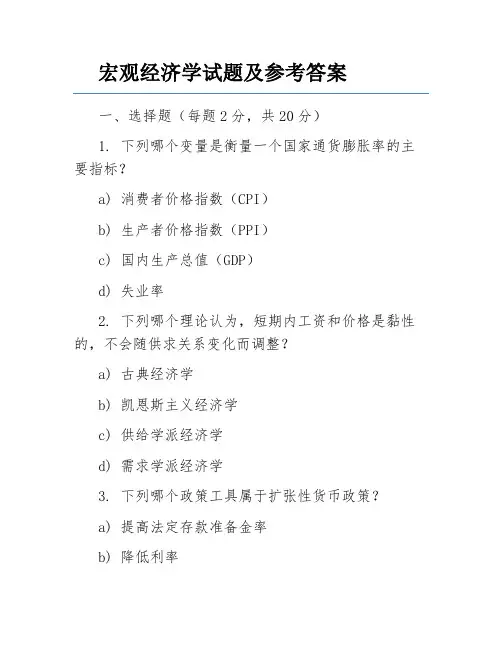
宏观经济学试题及参考答案一、选择题(每题2分,共20分)1. 下列哪个变量是衡量一个国家通货膨胀率的主要指标?a) 消费者价格指数(CPI)b) 生产者价格指数(PPI)c) 国内生产总值(GDP)d) 失业率2. 下列哪个理论认为,短期内工资和价格是黏性的,不会随供求关系变化而调整?a) 古典经济学b) 凯恩斯主义经济学c) 供给学派经济学d) 需求学派经济学3. 下列哪个政策工具属于扩张性货币政策?a) 提高法定存款准备金率b) 降低利率c) 增加政府支出d) 提高税率4. 国际贸易中的比较优势理论是由哪位经济学家提出的?a) 亚当·斯密b) 大卫·李嘉图c) 约翰·斯图亚特·密尔d) 阿尔弗雷德·马歇尔5. 下列哪个指标反映了一个国家的经济总量?a) 消费者价格指数(CPI)b) 生产者价格指数(PPI)c) 国内生产总值(GDP)d) 失业率6. 下列哪个政策属于紧缩性财政政策?a) 减少政府支出b) 降低税率c) 增加政府投资d) 提高税率7. 下列哪个市场结构最符合完全竞争市场的特征?a) 农产品市场b) 垄断市场c) 寡头垄断市场d) 完全垄断市场8. 下列哪个概念描述了商品和服务的价格水平总体上呈上升趋势的现象?a) 通货膨胀b) 通货紧缩c) 供需平衡d) 价格稳定9. 下列哪个理论认为,经济危机是由于市场机制失灵导致的?a) 古典经济学b) 凯恩斯主义经济学c) 供给学派经济学d) 奥地利学派经济学10. 下列哪个政策工具属于扩张性财政政策?a) 减少政府支出b) 降低税率c) 增加政府投资d) 提高税率二、简答题(每题10分,共30分)1. 请简要解释宏观经济学的基本概念和研究领域。
2. 请简要介绍凯恩斯主义经济学的主要观点和政策主张。
3. 请简要阐述货币政策和财政政策的区别及它们在调控经济中的作用。
三、论述题(每题25分,共50分)1. 请论述供给和需求曲线及其在市场经济中的作用。
宏观经济学习题(含答案)
宏观经济学局部第十五章一选择题1、以下哪一项不是转移支付〔〕?A退伍军人的津贴;B失业救济金;C贫困家庭补贴;D以上均不是。
2、作为经济财富的一种测定,GDP的根本缺点是〔〕。
A它测定的是一国国民生产的全部产品的市场价值;B它不能测定私人产出产量;C它所用的社会本钱太多;D它不能测定与存货增加相联系的生产。
3、在国民收入核算体系中,计入GNP的政府支出是指〔〕。
A政府购置物品的支出;B政府购置物品和劳务的支出;C政府购置物品和劳务的支出加上政府的转移支付之和;D政府工作人员的薪金和政府转移支付。
4、:消费额=6亿元,投资额=1亿元,间接税亿元,政府用语商品和劳务的支出费=1.5亿元,出口额=2亿元,进口额=1.8亿元,那么〔〕。
ANNP=8.7亿元BGNP=7.7亿元CGNP=8.7亿元DNNP=5亿元5所谓净出口是指〔〕。
A出口减进口;B进口减出口;C出口加出口;DGNP减进口。
6在三部门经济中,如果用支出法来衡量,GNP等于〔〕。
A消费+投资;B消费+投资+政府支出;C消费+投资+政府支出+净出口D消费+投资+净出口。
7、计入国民生产总值的有〔〕。
A家庭主妇的劳务折合成的收入;B出售股票的收入;C拍卖毕加索作品的收入;D为他人提供效劳所得收入。
8、国民生产总值与国民生产净值之间的差异是〔〕。
A直接税;B折旧;C间接税;D净出口。
9、按最终使用者类型,将最终产品和劳务的市场价值加总起来计算GDP的方法是〔〕。
A支出法;B收入法;C生产法;D增加值法。
10、用收入法计算的GDP等于〔〕。
A消费+投资+政府支出+净出口;B工资+利息+地租+利润+间接税;C工资+利息+中间产品+间接税+利润。
11、以下哪一项不是公司间接税〔〕。
A销售税;B公司所得税;C货物税;D公司财产税。
12、在统计中,社会保险税增加对〔〕项有影响。
AGDPBNDPCNIDPI。
三、名词解释1、政府购置支出12、政府转移支付3、国民生产净值4、国民收入5、个人收入6、个人可支配收入三、简答题1、对总产出的衡量为什么需要三个指标?2、在国民收入核算的收入法中,间接税和直接税分别起怎样的作用?3、现行国民收入核算指标有哪些缺陷?4、国民经济核算体系有何重要作用?四、论述题在开放经济中,国民经济均衡的条件是什么?怎样利用它判断国民收入水平的变动趋势?五、计算题某国企业在本国的总收益为200亿元,在外国的收益为50亿元;该国国民收入的劳动收入为120亿元,在外国的劳动收入为10亿元;外国企业在该国的收益为80亿元,外国人在该国的劳动收入为12亿元。
《宏观经济学》习题+答案
《宏观经济学》习题选择题一1、下列说法错误的是( D )A、GDP和GNP都是流量概念;B、GDP是地域概念,GNP是国民概念;C、GDP和GNP都是以市场交换为基础;D、GDP和GNP是同一概念,没有区别2、在国民收入支出法核算中,住房是属于( B )A、家庭消费支出;B、企业投资支出;C、政府购买支出;D、以上都不是3、经济学上的投资是指( D )A、企业增加一笔存货;B、建造一座住宅;C、企业购买一台计算机;D、以上都是4、在短期内,居民以下哪一部分的数额会大于可支配收入?(C )A、储蓄;B、消费;C、所得税;D、转移支付5、以下哪一项不列入GDP的核算?( C)A、出口到国外的一批货物;B、经纪人为一座旧房买卖收取的一笔佣金;C、政府发给贫困户的一笔救济金;D、保险公司收到一笔家庭的财产保险6、某国年人均GDP大于人均GNP,这说明该国家公民从外国取得的收入( B )外国公民从该国取得的收入A、大于;B、小于;C、等于;D、不确定7、社会保障支付属于( D )A、政府购买支出;B、政府税收:C、消费支出:D、政府转移支付8、下列哪一项不属于转移支付( C )A、退伍军人的津贴;B、失业救济金;C、出售国国债的收入;D、贫困家庭的补贴收入9、在广义的国民收入计算中,社会保险税增加对下列哪一项有影响(D )A、GNP;B、NNP;C、NI;D、PI10、下列不属于政府购买支出的是(A )A、政府为低收入者提供的生活保障;B、政府为政府公务员增加工资;C、政府向国外购买一批先进武器;D、政府在农村新建100所学校11、在国民收入核算中,下列哪一项不属于要素收入但被计入个人可支配收入中( B )A、租金;B、养老金;C、银行存款利息;D、拥有股票所获得的红利收入12、在下面四种情况中,投资乘数最大的是( C )A、MPC为0.6;B、MPC为0.3;C、MPS为0.1;D、MPS为0.313、如果投资增加120亿元,MPC为0.6,则收入水平将增加(A )A、300亿元;B、200亿元;C、720亿元;D、400亿元14、MPC与MPS之和等到于1,这是因为( C )A、任何两个边际量相加总是等于1;B、MPC和MPS都是直线;C、在简单的凯恩斯宏观经济模型中,国民收入不是用于消费,就是用于储蓄;D、经济中的投资水平不变15、投资乘数等于( B)A、投资变化除以收入变化;B、收入变化除以投资变化;C、边际消费倾向的倒数;D、(1-MPS)的倒数16、根据凯恩斯消费理论,随着收入增加( C )A、消费增加、储蓄下降;B、消费下降、储蓄增加;C、消费增加、储蓄增加;D、消费下降、储蓄下降17、在经济学中,下面哪一种行为被视为投资( C )A、购买公司证券;B、购买国债;C、建办公楼;D、生产性活动导致的当前消费18、如果资本边际效率低于市场利率,则企业投资( A )A、过多;B、过少;C、正好:D、都不对19、决定投资的因素不包括( D )A、利息率;B、资本边际效率;C、投资的利润率;D、国民收入20、IS曲线表示满足( D )关系A、收入-支出均衡;B、总供给和总需求均衡;C、储蓄和投资均衡;D、以上都对21、IS曲线上存在储蓄和投资均衡的收入和利率的组合点有( B )A、一个;B、无数个;C、一个或无数个;D、零个22、货币市场和商品市场的同时均衡,可以理解为( B )A、各种收入水平和各种利率水平上;B、一种收入水平和一定利率水平上;C、各种收入水平和一定利率水平上;D、一种收入水平和各种利率水平上23、如果人们的收入增加,则增加的将是( A )A、货币的交易需求;B、A和C;C、货币的投机需求;D、都不变动24、对利率变动反应最为敏感的是( C )A、货币的交易需求;B、货币的预防需求;C、货币的投机需求;D、ABC相同25、在经济萧条时期,政府可以采取的政策有( D )A、扩张性财政和紧缩性货币政策;B、紧缩性财政和紧缩性货币政策;C、紧缩性财政和扩张性货币政策;D、扩张性的财政和货币政策26、在古典区域内(A )A、货币政策有效;B、财政政策有效;C、货币政策无效;D、两者都有效27、在凯恩斯区域内(B )A、货币政策有效;B、财政政策有效;C、财政政策无效;D、两者都有效28、经济中存在失业时,应采取的财政政策工具是( A )A、增加政府支出;B、提高个人所得税;C、提高公司所得税;D、增加货币发行量29、在经济过热时,政府应采取( B )的财政政策A、扩大政府财政支出;B、减少财政支出;C、扩大财政赤字;D、减少税收30、实际GDP与潜在GDP的关系是(D )A、总是相等;B、实际GDP总是低于潜在GDP;C、实际GDP总是高于潜在GDP;D、实际GDP可以大于也可以小于或者等于潜在GDP,一般情况下,实际GDP小于潜在GDP31、在其他条件不变的情况下,如果价格水平下降,则总需求( A)A、增加;B、不变;C、减少;D、难以确定32、加速原理断言(A )A、GDP的增加导致投资数倍增加;B、GDP的增加导致投资数位减少;C、投资的增加导致GDP数位增加;D、投资的增加导致GDP数倍减少33、下述哪一项说法正确地表述了加速原理( D )A、投资的变动引起国民收入的数倍变动;B、消费支出随着投资的变动而数倍变动;C、投资的变动引起国民收入增长率数倍变动;D、消费需求的变动引起投资的倍数变动34、导致经济波动的投资主要是( D )A、存货投资;B、重置投资;C、愿意投资;D、固定资产投资35、在充分就业的情况下,下列( D )因素最可能导致通货膨胀A、进口增加;B、工资不变但劳动生产率提高;C、出口减少;D、政府支出不变但税收减少36、在下列引起通货膨胀的原因中,(C )最可能是成本推进的通货膨胀的原因A、银行存款增加;B、预算赤字;C、世界性商品价格的上涨;D、投资增加37、按照(D)的观点,菲利普斯曲线所阐明的通货膨胀率和失业率之间的替代关系是不存在的A、凯恩斯主义;B、货币主义;C、供给学派;D、理性预期学派38、“适应性预期”与“理性预期“的区别主要在( A)A、前者强调过去信息,后者强调现有的信息;B、后者以大量数学模型为论证依据,因而更科学;C、前者是凯恩斯主义的理论假设,内容陈旧,应被淘汰;D、前者难以解释与过去完全不一样的未来经济变动39、货币主义坚持以( B )作为货币政策的惟一控制指标A、利率;B、货币供给量;C、信货流量;D、准备金40、下面哪一种排序是经济周期阶段的正确顺序?( A )A、扩张—顶点—收缩—谷底;B、扩张-顶点-谷底-收缩;C、扩张-谷底—顶点-收缩;D、收缩-谷底—顶点—扩张41、某人正在等待某项工作,这种情况可以归类于( A)A、失业;B、就业;C、非劳动力;D、就业不足42、一个社会实现了充分就业,这就意味着( D )A、人人都有工作;B、想工作的人都有工作;C、失业率等于0;D、失业率处于自然失业率水一43、减少失业的政策,很可能会带来什么影响( B )A、没有影响;B、物价上涨;C、经济增长速度降低;D、以上都不对44、煤炭有多种用途,作为最终产品的是( A )A、家庭用于做饭;B、餐馆用于做饭;C、供热公司用于供应暖气;D、化工厂用作原材料45、下面不属于流量的是(C )A、国内生产总值;B、总投资;C、一国的资本量;D、净出口46、下面属于政府购买支出的是(A )A、空军购买一战机;B、退伍军人津贴;C、失业救济金;D、退休金47、如果消费函数为C=100+0.8(Y-T),则政府支出乘数是(D )A、8;B、1.25;C、4;D、548、可支配收入中,边际储蓄倾向如果为0.25,则边际消费倾向为( B )A、0.25;B、0.75;C、1.0;D、0.6449、国民收入决定理论认为国民收入均衡水平决定于(C )A、总收入;B、总投资;C、总需求;D、总供给50、平均储蓄倾向随收入的增加而(B )A、递减;B、递增;C、不变;D、不能确定51、如果MPC为0.8,则增加100亿元的投资将导致国民收入增加( C)亿元A、100;B、200;C、500;D、80052、在下列情况下,投资乘数最大的是(A )A、MPC=0.9;B、MPC=0.8;C、MPC=0.75;D、MPC=0.2553、边际消费倾向与边际储蓄倾向之和等于( D )A、大于1的正数;B、小于2的正数;C、0;D、154、根据消费函数,引起消费增加的因素是(B )A、价格水平下降;B、收入增加;C、储蓄增加;D、利率提高55、根据加速原理,引起净投资的原因是( A )A、产出的增加;B、价格提高;C、利息率下降;D、工资下降56、两部门经济的均衡国民收入决定的条件是( C )A、C=S;B、C=T;C、I=S;D、M=I57、三部门经济的均衡国民收入决定的条件是( A )A、Y=C+I+G;B、Y=C+I+T;C、C=Y+I+G;D、G=Y-C+I58、下列不会使均衡国民收入增加的情况是( D )A、税收减少;B、投资增加;C、政府购买增加;D、税收增加59、经济增长的标志是( D )A、失业率的下降;B、先进技术的使用;C、CPI的降低;D、社会生产能力的不断提高60、经济周期的中心是( C )A、价格的波动;B、利率的波动;C、国民收入的波动;D、就业率的波动61、导致LM曲线向右移动的因素有( D )A、投机货币需求减少;B、交易货币需求减少;C、货币供给量减少;D、货币供给量增加62、LM曲线表示满足以下哪一种关系?( D)A、收入-支出均衡;B、总供给与总需求均衡;C、储蓄与投资均衡;D、货币供求均衡63、如果某人因为某行业不景气而失去了工作,这种失业应属于( A )A、结构性失业;B、摩擦性失业;C、周期性失业;D、季节性失业64、天气寒冷,游客大大减少,某旅游区部分人失业,这种失业应属于( D )A、结构性失业;B、摩擦性失业;C、周期性失业;D、季节性失业65、下列哪一类不属于失业人员?( D )A、季节性工人;B、对当前工作不满意而待业在家的人;C、正在寻找工作的大学毕业生;D、半日工66、如果某人大学毕业后刚进入劳动力队伍还尚未找到工作,应属于(B )A、结构性失业;B、摩擦性失业;C、周期性失业;D、季节性失业67、为了降低失业率,应采取的货币政策工具是( B )A、提高税收;B、增加货币供给量;C、提高失业救济金;D、增加政府支出68、如果出现通货膨胀,实行的财政政策应是( B )A、减少税收;B、减少政府购买;C、增加转移支付;D、减少货币供给量69、根据菲利普斯曲线,降低通货膨胀率的办法是(A )A、提高失业率;B、降低失业率;C、实现充群分就业;D、增加货币供给量70、由于存在信息不对称或不完全信息所引起的失业属于( D )A、非自愿意失业;B、结构性失业;C、需求不足失业;D、摩擦性失业71、自然失业率指的是( C )A、是没有摩擦性失业时的失业率;B、是没有结构性失业时的失业率;C、是经济处于潜在产出水平时的失业率;D、恒为072、长期菲利普斯曲线表明( B )A、政府宏观经济政策只在一定范围内有效;B、政府宏观经济政策无效;C、自然失业率可以变动;D、失业与通货膨胀不可并存73、在其他条件不变情况下,政府增加公共设施投资,会引起国民收入( A )A、增加;B、不变;C、减少:D、不确定74、“双紧”政策会使国民收入( B )A、增加:B、减少:C、不变;D、不确定75、当一国经济出现过热时,中央银行可以在金融市场上( B)A、卖出国债,降低再贴现率;B、卖出国债,提高再贴现率;C、买进国债,降低再贴现率;D、买进国债,提高再贴现率76、( D)不能使LM曲线产生位移A、公开市场业务;B、降低法定准备金率;C、通货膨胀;D、扩大政府购买77、假定自然失业率是5%,而实际失业率是9%,根据奥肯定律GDP缺口占潜在GDP的比例为 (B )A、4%;B、8%;C、10%;D、不确定78、已知2012和2013年的CPI分别为140.3和144.5,则2014年的通货膨胀率大约为( B )A、6.7%;B、3.0%;C、10%;D、13.6%选择题二1、宏观经济学的中心理论是( C )A、价格决定理论B、工资决定理论C、国民收入决定理论D、汇率决定理论2、实际GDP等于( B )A、价格水平除以名义GDPB、名义GDP除以价格水平C、名义GDP乘以价格水平D、价格水平乘以潜在GDP3、已知消费为100亿元,投资为40亿元,间接税为50亿,政府的物品和劳务支出额为60亿,净出口为10亿元,则( D)A、NDP=210亿元B、GNP=210亿元C、NDP=120亿元D、无法确定GNP4、假定A国2010年和2013年的名义GDP分别为12000亿元和20000亿元,GDP的折算数分别为1、0和1、5,可推论2013年比2010年(C)A、名义GDP上升33%B、实际GDP不变C、实际GDP上升11%D、实际GDP下降5、如果某人个人收入等于8700元,个人所得税等于900元,消费5300元,利息支付总额为500元,个人储蓄2000元,则个人可支配收入等于(B)A、7300元B、7800元C、5800元D、无法确定6、甲公司为乙公司提供市场营销策划服务,双方约定报酬为10万元,事后乙公司为甲公司提供了价值6万元的产品直接抵消了部分策划费用,再用2万元的售后服务抵消了剩余策划费用的部分款项,最后支付2万元现金给甲公司。
宏观经济学习题库(附参考答案)
习题库第一章导论一、名词解释宏观经济学、总量分析、非均衡分析、凯恩斯革命二、简答题1、宏观经济学有什么特点?2、宏观经济学主要研究哪些问题?3、现代宏观经济学是如何产生与演变的?第二章国民收入核算一、名词解释GDP、GNP、NDP、NI、PI、PDI、名义GDP、实际GDP、GDP紧缩指数二、选择题1、下列那些项目应计入GDP?( )。
A. 政府转移支付B. 购买一辆用过的卡车C. 购买普通股票D. 购买一块地产2、已知某一经济中的消费额为6亿元,投资额为1亿元,间接税为1亿元,政府用于物品和劳务的支出额为1.5亿元,出口额为2亿元,进口额为1.8亿元,则()。
A. NDP=8.7亿元B. GDP=7.7亿元C. GDP=8.7亿元D. NDP=5亿元3、所谓净出口是指()。
A. 出口减进口B. 进口减出口C. 出口加进口D. GNP减出口4、在三部门经济中,如果用支出法来衡量,GDP等于()。
A. 消费+投资B. 消费+投资+政府支出C. 消费+投资+政府支出+净出口D. 消费+投资+进出口5、GDP与NDP之间的差别是()。
A. 直接税B. 折旧C. 间接税D. 净出口6、按最终使用者类型,将最终产品和劳务的市场价值加总起来核算GDP的方法是()。
A. 支出法B. 收入法C. 生产法D. 增加价值法7、在统计中,社会保险税增加对()有影响?A. GDPB. NDPC. NID. PI三、简答题1、指出下列各项中,哪些是中间产品,哪些是最终产品?①小王购买一本杂志②某电脑公司购买一批英特尔公司生产的芯片③某政府机构购买一批红旗轿车④旅游时付给入住酒店的房租⑤律师支付租用办公室的房租⑥家庭支付的水电费⑦美国公司向中国购买的农产品2、GDP的统计口径是否忽视了对中间产品生产的核算?3、在证券市场购买股票和债券属于经济学意义上的投资活动吗?4、为什么政府转移支付不能计入GDP?5、为什么间接税应该计入GDP?6、GDP指标有哪些缺陷或不足?7、为什么要区分名义国内生产总值和实际国内生产总值?8、国内生产总值与国民生产总值关系如何?四、计算题1、若某国GDP为8800单位,总投资为1150单位,净投资为292单位,消费为5800单位,政府购买的产品和劳务价值为1500单位,间接税为620单位,政府财政盈余为44单位,求该国NDP、净出口、个人可支配收入、个人储蓄各为多少。
宏观经济学试题答案
宏观经济学试题答案一、选择题1. 宏观经济学主要研究的是()A. 个体经济行为B. 企业经营决策C. 整体经济现象D. 货币政策制定答案:C2. 以下哪一项不是国民收入核算中的组成部分?()A. 消费B. 投资C. 政府购买D. 人口迁移答案:D3. 通货膨胀是指()A. 货币供应量减少B. 物价总水平持续上升C. 经济增长放缓D. 失业率上升答案:B4. 经济周期的四个阶段中,哪两个阶段通常伴随着经济衰退?()A. 顶峰和低谷B. 扩张和复苏C. 低谷和复苏D. 扩张和顶峰答案:C5. 以下哪一项政策不是政府用来调节经济的手段?()A. 财政政策B. 货币政策C. 贸易政策D. 教育政策答案:D二、填空题1. 宏观经济学中的“三驾马车”指的是______、______和______。
答案:消费、投资、政府支出2. 货币供应量增加,通常会导致______下降,进而可能刺激______。
答案:利率、投资3. 在开放经济条件下,经常账户余额等于______加上______。
答案:贸易余额、转移支付4. 菲利普斯曲线描述了______和______之间的关系。
答案:失业率、通货膨胀率5. 经济全球化的主要推动力之一是______。
答案:技术进步三、简答题1. 请简述宏观经济学的研究对象和主要目标。
答:宏观经济学研究的是整个经济体系的行为和表现,主要关注国民收入、就业、物价水平、经济增长和国际收支等宏观经济变量。
其主要目标是实现高就业、稳定物价、经济增长和国际收支平衡。
2. 说明总需求和总供给在宏观经济中的作用。
答:总需求是指在一定时期内,所有经济主体对商品和服务的总购买力。
总供给则是指在同一时期内,经济体系能够生产的商品和服务的总量。
总需求的变化影响着物价水平和产出,而总供给的变化则影响着生产能力和就业水平。
两者的平衡关系是宏观经济稳定的关键。
3. 描述货币政策的基本原理及其对经济的影响。
答:货币政策是中央银行为了实现宏观经济目标而对货币供应量和利率进行调控的政策。
- 1、下载文档前请自行甄别文档内容的完整性,平台不提供额外的编辑、内容补充、找答案等附加服务。
- 2、"仅部分预览"的文档,不可在线预览部分如存在完整性等问题,可反馈申请退款(可完整预览的文档不适用该条件!)。
- 3、如文档侵犯您的权益,请联系客服反馈,我们会尽快为您处理(人工客服工作时间:9:00-18:30)。
Fiscal Policy, Part 1Multiple Choice Questions1.Federal government outlays include:a.Transfer payments, grants to states, interest payments on the national debt and income taxrevenues.ernment purchases, transfer payments, grants to states and interest payments on thenational debt.c.Grants to states, interest payments on the national debt, income tax revenues and governmentpurchases.d.Interest payments on the national debt, income tax revenues, government purchases and transferpayments.2.The major component of federal government consumption is spending on:a.Foreign aid.b.National defense.c.Social Security, Medicare and Medicaid.d.Capital goods,e.g. highways and schools.3. A federal government surplus is said to exist when:a.Federal outlays are equal to federal revenues.b.Federal outlays are less than federal revenues.c.Federal outlays are greater than federal revenues.d.None of the above; federal government surpluses don’t exist.4.The government budget constraint says that:a.Increases in spending must be matched by increases in revenue.b.The difference between spending and revenues must equal the amount of new bond issues.c.State and local governments, in aggregate, cannot spend more than the federal government.d.Interest on government debt must be paid before tax revenues are spent on goods and services ordisbursed as transfer payments.Fiscal Policy, Part 15.Employing the government budget diagram shown above, assume that the economy is initially inequilibrium at point A. The movement A to D represents:a. A decrease in government spending and a decrease in taxes.b.An increase in government spending and an increase in taxes.c.An increase in government spending and/or a decrease in taxes.d. A decrease in government spending and/or an increase in taxes.6.In the diagram above, the impact of automatic stabilization is depicted by the movement from:a. A to B.b. A to D.c. A to F.d. C to F.7.In the diagram above, if the budget line is BB0 and the natural real GDP is $5300, the structural surplus ordeficit is:a.The vertical distance between F and C.b.The vertical distance between D and A.c.The horizontal distance between A and F.d.None of the above.Fiscal Policy, Part 18.In the diagram above, if the budget line BB 1, the natural real GDP is $5300, and actual real GDP is $5000,then the cyclical budget surplus or deficit is the:a.Vertical distance between A and C. b.Vertical distance between D and F. c.Horizontal distance between B and D. d.Horizontal distance between A and F.9.An increase in the tax rate, t:a.Will rotate the budget line upward. b.Will shift the budget line downward. c.Will increase the slope of the budget line. d.Both a. and c.10.The full employment surplus is:a.G + T. b.T + t*Y P- G. c.Y – T – t*Y P . d.Y P + G + T + t*Y P . 11.The actual government budget deficit ________ be used to determine the effectiveness of discretionaryfiscal policy actions because ________.a.can; it includes non-discretionary spending changes b.can; it excludes automatic stabilization expenditures c.cannot; it includes non-discretionary spending changes d.cannot; it excludes non-discretionary spending changesFiscal Policy, Part 1Discussion Questions1. Identify the four main categories of government spending and give an example of each.The four main components of government spending are expenditures to purchase goods and services,which can be subdivided into government investment spending on capital goods such as highwaysand schools and government consumption spending on such things as operating national parks andproviding police and fire protection; transfer payments such as Social Security and Medicare benefits;grants in aid through which the federal government assists state and local governments with, forexample, spending to provide homeland security; and net interest payments to holders of governmentbonds, net of interest paid to government.2.What are the government’s four main revenue sources?The four main revenue sources are personal taxes, contributions for social insurance (Social Securitytaxes), taxes on production (mainly sales taxes) and imports (tariffs), and corporate profits taxes.3.What is a budget deficit and what are the two main ways in which the government can finance deficitspending?A government budget deficit means that government spending over some time period is greater thanthe revenues government has collected over that period. According to government’s budget constraint, when revenues are insufficient to pay for spending, government must either borrow byissuing new bonds and going deeper into debt or print money, which increases the supply of high-powered money (currency in circulation and bank reserves) and increases the money supply.4.You have heard that the actual government deficit for the current year is going to be $30 billion greaterthan in the previous year. Based on this projection, what conclusions can you make regarding thegovernment’s fiscal policy?No definitive conclusion on the government’s fiscal policy can be made with the information given in the question because the actual deficit can change due to either a change in fiscal policy or a changein the level of output. To determine whether fiscal policy is expansionary or restrictive, the level ofthe natural employment deficit must be examined.Fiscal Policy, Part 15.Respond to the following statements about an economy where the government budget deficit has increasedduring a recession.a.The increase in the budget deficit indicates that policymakers have implemented expansionaryfiscal policies to bring the economy out of recession.b.The increase in the budget deficit indicates that fiscal policymakers have been irresponsible. Theyshould enact policies to reduce the deficit, either increase taxes and/or reduce governmentspending.Both statements indicate confusion between a cyclical deficit increase and a structural one. Theincrease in the budget deficit is a cyclical increase resulting from the recession. It indicates neitherthat policymakers have implemented expansionary fiscal policies nor that they have beenirresponsible. Enactment of discretionary restrictive fiscal policies could plunge the economy evendeeper into recession and result in an even larger budget deficit rather than a smaller one.Analytical QuestionsThese questions should be answered based on the standard models of analysis developed in class.The information in the various parts of the question is sequential and cumulative.Fiscal Policy, Part 11.The AD/AS Model with a Budget Balance Line. Country A’s economy, which is characterized by stickywages and prices, is initially (i.e., in Year 0) at the natural rate of unemployment with a substantial budget surplus.a.Based only on this information, use AD/AS Model and BB Line diagrams to clearly andaccurately show Country A’s initial (1) economic output, (2) inflation, and (3) governmentbudget balance. These diagrams should be drawn in BLACK.Fiscal Policy, Part 1b.Provide an economic explanation of what you have shown in your diagrams above.Because the unemployment rate was initially at the natural rate of unemployment, economic output was initially at its potential level, i.e., Y0 = Y P0 with inflation stable at π0.Because the government initially had a substantial budget surplus, the actual budget balance was in surplus, i.e., ABB0 > 0.Fiscal Policy, Part 1c.In Year 1, the government undertakes a $100 billion spending program to significantly increasethe number of school teachers. This additional spending is fully funded by an increase in tax rates.Incorporating only this additional information, clearly and accurately show on your diagramsabove what, if anything, happens to Country A’s (1) economic output, (2) inflation, and (3)RED.government budget balance. These changes should be drawn ind.Provide an economic explanation of what you have shown in your diagrams above. Discusswhat, if anything, happens to Country A’s (1) economic output, (2) inflation, and (3) government budget balance. Be sure to explain why these changes take place and what causes them.In Year 1, four events occur.First, the government increases spending by $100 billion. This increases plannedexpenditures and aggregate demand for any given inflation. This is represented by arightward shift of the aggregate demand curve from AD0 to AD1a. At every level ofinflation, economic output has increased.Second, the increase in government spending reduces the actual budget balance forany given level of economic output. This is represented by a downward shift of thebudget balance line from BB0 to BB1a.Third, the government fully funds the increase in government spending with anincrease in tax rates. This decreases disposable income, planned expenditures, andaggregate demand for any given inflation. This is represented by a leftward shift ofthe aggregate demand curve from AD1a to AD1.[The leftward shift of the aggregate demand curve from the tax rate increase issmaller than the rightward shift of the aggregate demand curve from thegovernment spending increase because the tax multiplier is smaller than theexpenditure multiplier.]Fourth, the increase in tax rates rotates the budget balance line upward from BB1ato BB1. The budget balance line BB1 intersects potential output, Y P0, at ABB0because the dollar amount of a tax rate change is always measured at potentialoutput.At the initial inflation of π0, aggregate demand is now greater than the long-run equilibriumaggregate supply that businesses want to produce (which is given by potential output, Y P0).This excess demand causes inflation to increase. The increase in inflation has two effects.First, the increase in inflation causes the central bank, acting according to theTaylor Principle, to increase the real policy interest rate, a movement along the MPcurve. The higher real policy interest rate increases the cost of borrowing, resultingin less borrowing and a decrease in planned expenditures and aggregate demand, amovement along the aggregate demand curve AD1.Fiscal Policy, Part 1Second, as inflation increases, actual inflation rises above expected inflation so thatbusinesses can raise their prices more quickly than they anticipated. This promptsbusinesses to increase their production, a movement along the short-run aggregatesupply curve SRAS1(πe = π0).This adjustment process continues until inflation increases to π1 when aggregate demand and short-run aggregate supply are once again equal with economic output at Y1. The increase in economic output from Y0 to Y1 also increases tax revenues, increasing the budget surplus from ABB0 to ABB1.When the Year 1 effects are complete, the economy is in a new short-run equilibrium where:(1)Economic output has increased from Y0 = Y P0 to Y1,(2)Inflation has increased from π0 to π1, and(3)The government budget surplus has increased from ABB0 to ABB1.Although the economy is in short-run equilibrium it is not in general equilibrium.Fiscal Policy, Part 1e.In Year 2, the central bank decides to target the real policy interest rate at its initial (i.e., Year 0)level. Incorporating only this additional information, clearly and accurately show on yourdiagrams above what, if anything, happens to Country A’s (1) economic output, (2) inflation, and(3) government budget balance. These changes should be drawn inBLUE.f.Provide an economic explanation of what you have shown in your diagrams above. Discusswhat, if anything, happens to Country A’s (1) economic output, (2) inflation, and (3) government budget balance. Be sure to explain why these changes take place and what causes them.In Year 2, two events happen.First, inflationary expectations are determined by a one-year adaptive process.Because actual inflation in Year 1, π1, is greater than expected inflation in Year 1,πe1 = π0, expected inflation in Year 2 adjusts upward to actual inflation in Year 1,i.e., πe2 =π1. This is represented by an upward shift of the short-run aggregatesupply curve from SRAS1(πe = π0) to SRAS2(πe = π1).Second, the central bank decides to target the real policy interest rate at its initial(i.e., Year 0) level. This is an discretionary expansionary monetary policy, reducingthe real policy interest rate for any given inflation. This is represented by adownward shift of the MP curve. A lower real policy interest rate reduces the cost ofborrowing, resulting in an increase in borrowing, planned expenditures, andaggregate demand for any given inflation. This is represented by a rightward shiftof the aggregate demand curve from AD1 to AD2.[The aggregate demand curve AD2 may be to the left of, equal to, or to the right ofthe aggregate demand curve AD1a.]At inflation of π1, aggregate demand is now greater than the long-run equilibrium aggregatesupply that businesses want to produce (which is given by potential output, Y P0). This excessdemand causes inflation to increase. The increase in inflation has two effects.First, the increase in inflation causes the central bank, acting according to theTaylor Principle, to increase the real policy interest rate, a movement along the MPcurve. The higher real policy interest rate increases the cost of borrowing, resultingin less borrowing and a decrease in planned expenditures and aggregate demand, amovement along the aggregate demand curve AD2.Second, as inflation increases, actual inflation rises above expected inflation so thatbusinesses can raise their prices more quickly than they anticipated. This promptsbusinesses to increase their production, a movement along the short-run aggregatesupply curve SRAS2(πe = π1).Econ 100B / UGBA 101B: Macroeconomic AnalysisPost Lecture #22 Exercise ANSWERSFiscal Policy, Part 1This adjustment process continues until inflation increases to π2 when aggregate demand and short-run aggregate supply are once again equal with economic output at Y2. The increase in economic output from Y1 to Y2 also increases tax revenues, increasing the budget surplus from ABB1 to ABB2 along the budget balance line BB1.When the Year 2 effects are complete, the economy is in a new short-run equilibrium where:(1)Economic output has increased from Y1 to Y2,(2)Inflation has increased from π1 to π2, and(3)The government budget surplus has increased from ABB1 to ABB2.Although the economy is in short-run equilibrium it is still not in general equilibrium.Fiscal Policy, Part 1b.In Year 1, the economy experiences a severe drought that leads to sharply higher food prices. Inaddition, household and business optimism about the economy declines substantially. The higherfood prices have a larger effect on economic output than the decline in optimism. Based only onthis additional information, clearly and accurately show in your diagrams above what, ifanything, happens to the economy’s (1) economic output, (2) inflation, (3) actual budget balance,RED.and (4) structural budget balance. These changes should be drawn inc.Provide an economic explanation of what you have shown in your diagrams above. Discusswhat, if anything, happens to the economy’s (1) economic output, (2) inflation, (3) actual budget balance, and (4) structural budget balance. Be sure to explain why these effects take place andwhat causes them.In Year 1, four separate events occur:First, inflation expectations are determined by a one-period (i.e., one-year) adaptiveprocess. Because the economy has a small positive output gap in Year 0 actualinflation in Year 0, π0, was greater than expected inflation in Year 0, πe0 = π-1, i.e., π0> πe0. As a result, inflation expectations in Year 1 adjust upward to actual inflationin Year 0, i.e., πe1 =π0. This is represented by a upward shift of the short-runaggregate supply curve from SRAS0(πe = π-1) to SRAS1a(πe = π0). Inflation is higherfor any given level of economic output.Second, a severe drought that leads to sharply higher food prices is a negative short-run aggregate supply shock, i.e., ρ1 > 0. This is represented by an upward shift ofthe short-run aggregate supply curve from SRAS1a(πe =π0) to SRAS1(πe =π0).Inflation is higher for any given level of economic output.Third, substantial declines in household and business optimism about the economyare a negative aggregate demand shock. This is represented by a leftward shift ofthe aggregate demand curve from AD0 to AD1. Economic output is lower for anygiven inflation.Because of the negative short-run aggregate supply shock, inflation increases. As inflationincreases, the central bank raises the real policy interest rate according to the TaylorPrincipal. A higher real policy interest rate increases the cost of borrowing that reduces theamount of borrowing and aggregate expenditures. In turn, this reduces economic output.Fourth, because there were no discretionary fiscal policy changes (neithergovernment purchases nor tax rates changed) the budget balance line, BB0, did notchange, i.e., BB1 = BB0. Consequently, there was no change in the structural budgetbalance, i.e., SBB1 = SBB0. However, the decline in economic output from Y0 to Y1caused tax receipts to decline endogenously. This increased the budget deficit(reduced the budget balance) along the budget balance line BB1 from ABB0 to ABB1.Fiscal Policy, Part 1When the Year 1 effects are complete, the economy is in a new short-run equilibrium where:(1)Economic output has declined from Y0 to Y1,(2)Inflation has increased from π0 to π1,(3)The actual budget balance has declined from ABB0 to ABB1, and(4)The structural budget balance has not changed, i.e., SBB0 = SBB1.Fiscal Policy, Part 1d.In Year 2, the government enacts a tax rate change that affects total tax revenues by the exactmagnitude needed to eliminate Year 1’s actual budget imbalance. Based only on this additional information, clearly and accurately show in your diagrams above what, if anything happens tothe economy’s (1) economic output, (2) inflation, (3) actual budget balance, and (4) structuralbudget balance. These changes should be drawn inBLUE.e.Provide an economic explanation of what you have shown in your diagrams above. Discusswhat, if anything, happens to the economy’s (1) economic output, (2) inflation, (3) actual budget balance, and (4) structural budget balance. Be sure to explain why these effects take place andwhat causes them.In Year 2, four separate events occur:First, inflation expectations are determined by a one-period (i.e., one-year) adaptiveprocess. Because the economy had a negative short-run aggregate supply shock inYear 1, actual inflation in Year 1, π1, was greater than expected inflation in Year 1,πe1 = π0, i.e., π1 > πe1. As a result, inflation expectations in Year 2 adjust upward toactual inflation in Year 1, i.e., πe2 = π1. However, the price shock disappeared, i.e. ρ= 0. This combination is represented by a downward shift of the short-run aggregatesupply curve from SRAS1(πe = π0) to SRAS2(πe = π1). Inflation is lower for any givenlevel of economic output.Second, the government enacts a tax change that affects total tax revenues by theexact magnitude of Year 1’s actual budget imbalance. Because there was an actualbudget deficit in Year 1 of ABB1, the government must increase tax rates sufficientto raise ABB1 in additional tax revenues. This is represented by an upward rotationof the budget balance line from BB1 to BB2 which intersects the 0 line at Y1. Thisincreases the structural budget balance from SBB1 to SBB2 which is alwaysmeasured at potential output, Y P.Third, the increase in tax rates is a contractionary fiscal policy that reducesdisposable income, consumer spending, and economic output for any given inflation.This is represented by a leftward shift of the aggregate demand curve from AD1 toAD2. Economic output is lower for any given inflation.At inflation of π1, there is excess supply in the economy, causing inflation to decline. Asinflation declines the central bank reduces the real policy interest rate according to theTaylor Principal. A lower real policy interest rate decreases the cost of borrowing whichincreases the amount of borrowing and increases aggregate expenditures. This limits thedecline in economic output that occurs from the negative aggregate demand shock.Fourth, with the decline in economic output from Y1 to Y2, tax revenues are reducedendogenously along the Budget Balance Line BB2. As a result of these reduced taxrevenues, the actual budget balance decreases from 0 to ABB2.Fiscal Policy, Part 1When the Year 2 effects are complete, the economy is in a new short-run equilibrium where:(1)Economic output has declined from Y1 to Y2.(2)Inflation has declined from π1 to π2. (π2 could be >, =, or < π0 depending on theorder of magnitude of the shifts in the SRAS and AD curves.)(3)The actual budget balance has increased from ABB1 to ABB2. (ABB2 could be >,=, < ABB1 depending on the magnitude of the decline in economic output andthe rotation of the Budget Balance Line. In the “real” world, it is most likelythat ABB2 < ABB1.)(4)The structural budget balance has increased from SBB1 = SBB2.。
